Which Of The Computer Components Below Will Most Likely Draw More Power Than The Others
Computer Hardware
Computer Hardware
The computer is an amazingly useful general-purpose engineering, to the point that now cameras, phones, thermostats, and more than are all now little computers. This section volition introduce major parts and themes of how estimator hardware works. "Hardware" refers the physical parts of the figurer, and "software" refers to the code that runs on the computer.
Chips and Transistors
Here is a silicon chip inside its plastic package. I pulled this out of the e-waste pile at the Stanford CS building, and so information technology'south probably kind of sometime. This is a pocket-sized chip with just a few "pins" of electrical connectedness. Later nosotros'll see a bigger chip with hundreds of pins.
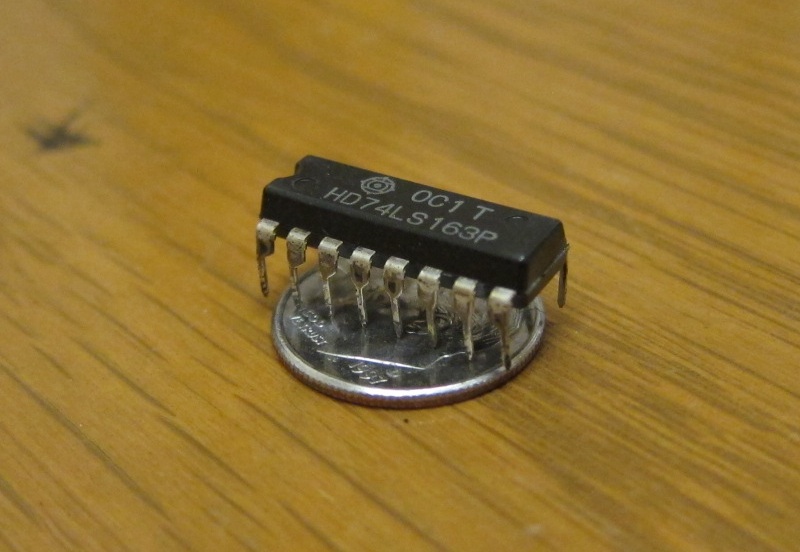
Inside the plastic bundle is a fingernail sized silicon chip with transistors and other components etched on its surface. Tiny wires connect the fleck to the outside. (CC licensed attribution sharealke iii. wikipedia user Zephyris)
![]()
Modern computers utilize tiny electronic components which tin can be etched onto the surface of a silicon chip. (See: wikipedia chip) Annotation that silicon (fries, solar panels) and silicone (soft rubbery fabric) are different!
The most common electronic component is the "transistor" which works as a sort of amplifying valve for a flow of electrons. The transistor is a "solid land" device, meaning it has no moving parts. It is a bones edifice block used to construct more complex electronic components. In particular, a "bit" (beneath) tin be built with an arrangement of 5 transistors. The transistor was invented in the early on 1950'due south, replacing the vacuum tube. Since then, transistors have been made smaller and smaller, allowing more and more than of them to exist etched onto a silicon flake.
Moore's Law
Moore'southward constabulary (Gordon Moore, Intel co-founder) states that the density of transistors on a fleck doubles about every 2 years or then (sometimes listed every bit every xviii months). The increment is due to improved fleck making engineering science. It is non a scientific law, just a broad prediction that seems to keep working. More than broadly, information technology captures the idea that per dollar, estimator technology (not just transistors) gets exponentially meliorate as time goes forth. This is quite clear if you look at the cost or capability of computers/cameras etc. you have owned. Moore's Police results in more than capable computers (compare what an iPhone vii can do vs. the original iPhone) as well every bit cheaper computers (less capable computers evidence up everywhere, similar in thermostats and cars).
Computers in life: Control Systems
Control Organization / Moore's Flashlight Demo
Computer Hardware - CPU, RAM, and persistent storage
Now let'southward talk virtually the three major parts that brand up a estimator -- CPU, RAM, and Persistent Storage. These three are found in all computers: laptops, smartphones, and tablets.
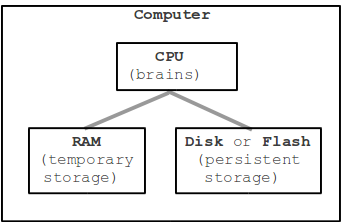
1. CPU
CPU - Central Processing Unit of measurement - inevitably referred to as the "brains" of the computers. The CPU does the active "running" of code, manipulating data, while the other components have a more than passive function, such as storing data. When nosotros say that a calculator tin can "add together two numbers, a billion times a second" .. that'southward the CPU. When yous hit the Run push, the CPU ultimately "runs" your code. Afterwards on, we will complete the flick of how your Javascript code is run by the CPU.
Aside: CPU "Cores"
CPU Examples
CPU Variant: GPU - Graphics Processing Unit of measurement
2. RAM
RAM - Random Access Memory, or merely "memory". RAM is the working scratchpad memory the computer uses to store code and data that are existence actively used. RAM is effectively a storage area of bytes under the control of the CPU. RAM is relatively fast and able to retrieve the value of any detail byte in a few nanoseconds (1 nanosecond is 1 billionth of a second). The other main feature of RAM is that it only keeps its state so long equally it is supplied with power -- RAM is not "persistent" storage.
Suppose you lot are working on your computer and it of a sudden loses power and the screen goes bare. Yous sympathise that what you were working on is gone. RAM has been wiped clean, leaving you only with what you last saved to disk (below).
RAM Examples
3. Persistent Storage: Difficult Drive, Flash Drive
How a Hard Drive Works Video (Webm is an open standard video format, works in Firefox and Chrome). 4:30 in the video to see some reading/writing of $.25.
Persistent Storage, Newer Engineering science: Flash
Persistent storage - long term storage for bytes as files and folders. Persistent means that the bytes are stored, even when ability is removed. A laptop might employ a spinning hard drive (too known as "hd") for persistent storage of files. Or information technology could use a "flash drive", likewise known as a Solid State Deejay (SSD), to store bytes on flash chips. The hard drive reads and writes magnetic patterns on a spinning metal deejay to store the bytes, while flash is "solid country": no moving parts, just silicon chips with tiny groups of electrons to store the bytes. In either example, the storage is persistent, in that information technology maintains its state even when the ability is off.
A flash drive is faster and uses less power than a hard disk. However, per byte, flash is significantly more expensive than hard bulldoze storage. Flash has been getting cheaper, so it may have over niches at the expense of hard drives. Wink is much slower than RAM, and so it is non a good replacement for RAM. Notation that Adobe Flash is an unrelated concept; it is a proprietary media format.
Wink storage is what underlies USB thumb drives, SD cards for use in cameras, or the built-in storage in a tablet or phone.
File System

The hard drive or flash drive provides persistent storage as a apartment area of bytes without much structure. Typically the hard disk or wink disk is formatted with a "file system" which organizes the bytes into the familiar pattern of files and directories, where each file and directory has a somewhat useful name like "resume.txt". When you connect the drive to a figurer, the reckoner presents the drive's file organization to the user, allowing them open files, motility file effectually, etc.
Substantially, each file in the file organisation refers to a block of bytes, and then the "flowers.jpg" name refers to a cake of 48KB of bytes which are the data of that epitome. The file system in effect gives the user a name (and probably an icon) for a block of information bytes, and allows the user to perform operations on that data, like movement it or copy information technology or open it with a program. The file system also tracks data nearly the bytes: how many there are, the time they were last modified.
Microsoft uses the proprietary NTFS file system, and Mac OS X has its Apple proprietary HFS+ equivalent. Many devices (cameras, MP3 players) use the very old Microsoft FAT32 file system on their flash cards. FAT32 is an old and archaic file organization, but it is good where wide support is of import.
Persistent Storage Examples
Pictures of Hardware
Beneath are images of a depression-terminate Shuttle estimator with a 1.8ghz CPU, 512MB of RAM, and a 160GB hard drive. It cost about $200 in around 2008. It bankrupt, and so became a classroom case.
Hither is the flat "motherboard", a little smaller than a 8.five x 11 piece of paper, that the diverse components plug in to. At the center is the CPU. At the far correct is the RAM memory. Just to the right of the CPU are a couple support chips. Prominently, one of the chips is covered with a copper "heatsink" .. this presses tightly against the chip, dissipating the heat from the chip into the surrounding air. The CPU also had a very big heatsink, simply it was removed to make the CPU visible.
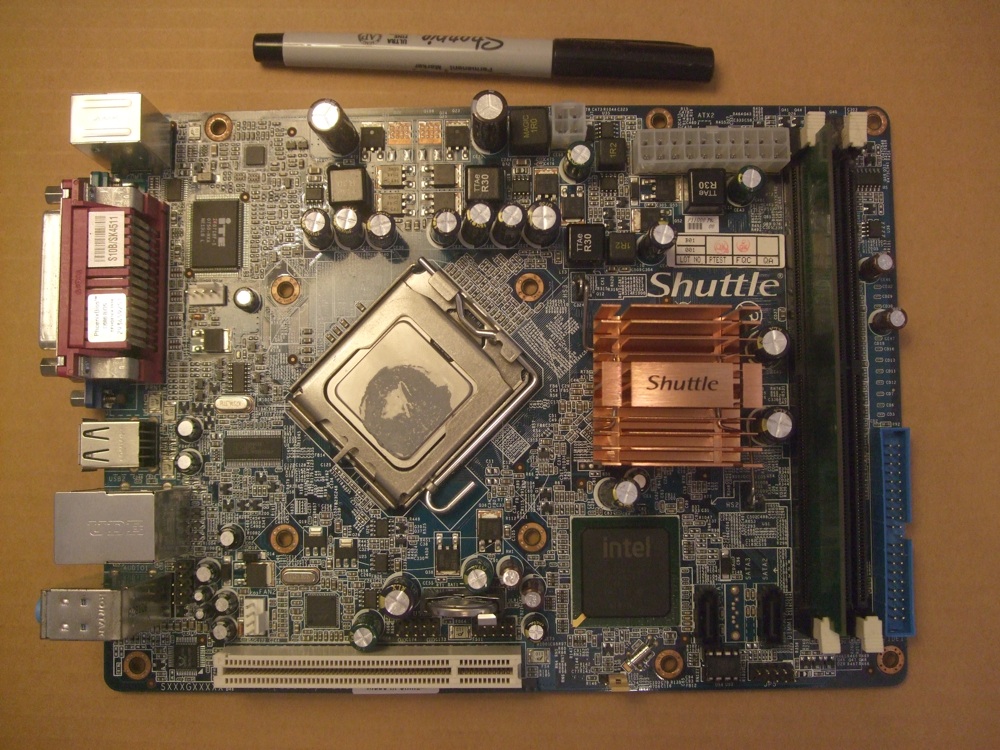
The CPU is held tightly against the motherboard past a lilliputian lever machinery. Here the machinery is released and then the CPU can be picked up. The fingernail sized CPU is packaged underneath this metal embrace which helps conduct the heat from the CPU upwardly to its heatsink. The grayness stuff on the metal chip embrace is "thermal paste", a textile which helps behave estrus from the fleck housing to its (not shown) heatsink.
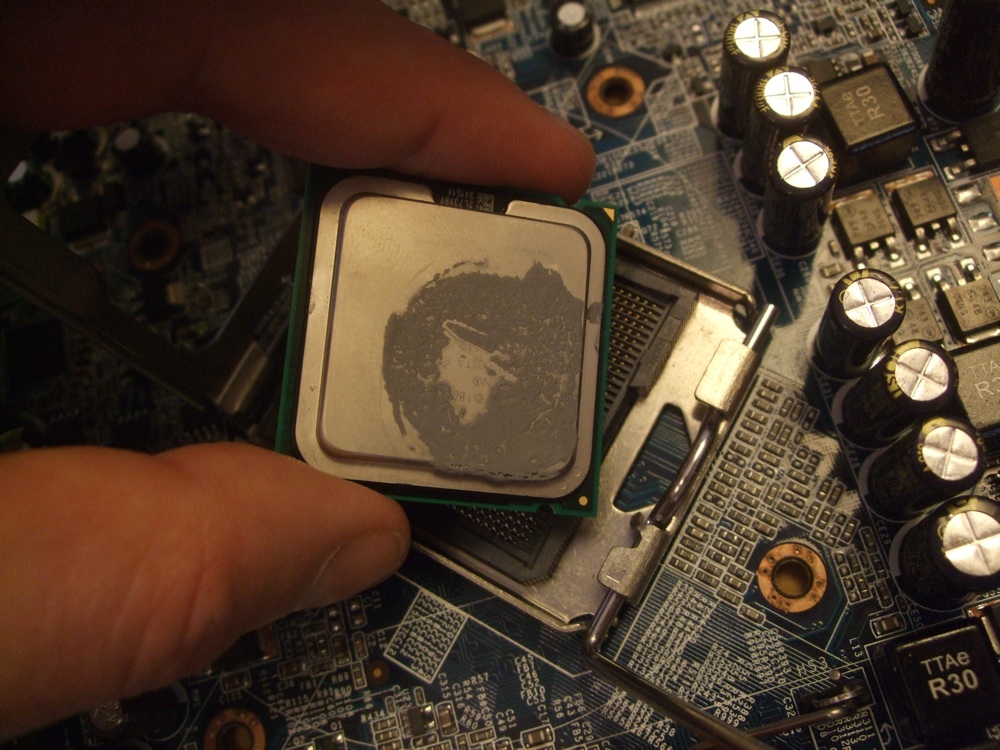
Flipping the CPU over shows the piddling gold pads on the lesser of the CPU. Each pad is continued past a very fine wire to a spot on the silicon scrap.
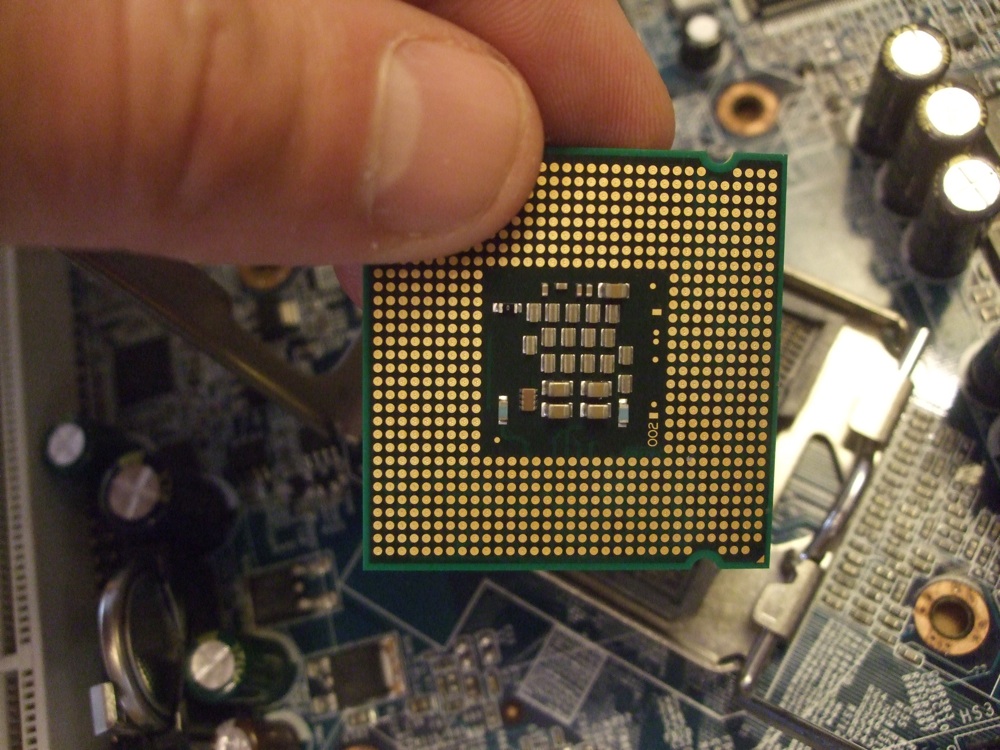
Hither is a picture show of another chip, but with the top packaging removed. You see the pinky-fingernail silicon chip at the center with the tiny transistor details etched onto information technology. At the chip border, see the very fine wires connecting parts of the chip to outside pads (CC licensed attribution sharealke 3. wikipedia user Zephyris)
![]()
Now looking from the side, the heatsink and the RAM memory card can be seen more clearly, sticking upwards from the motherboard.
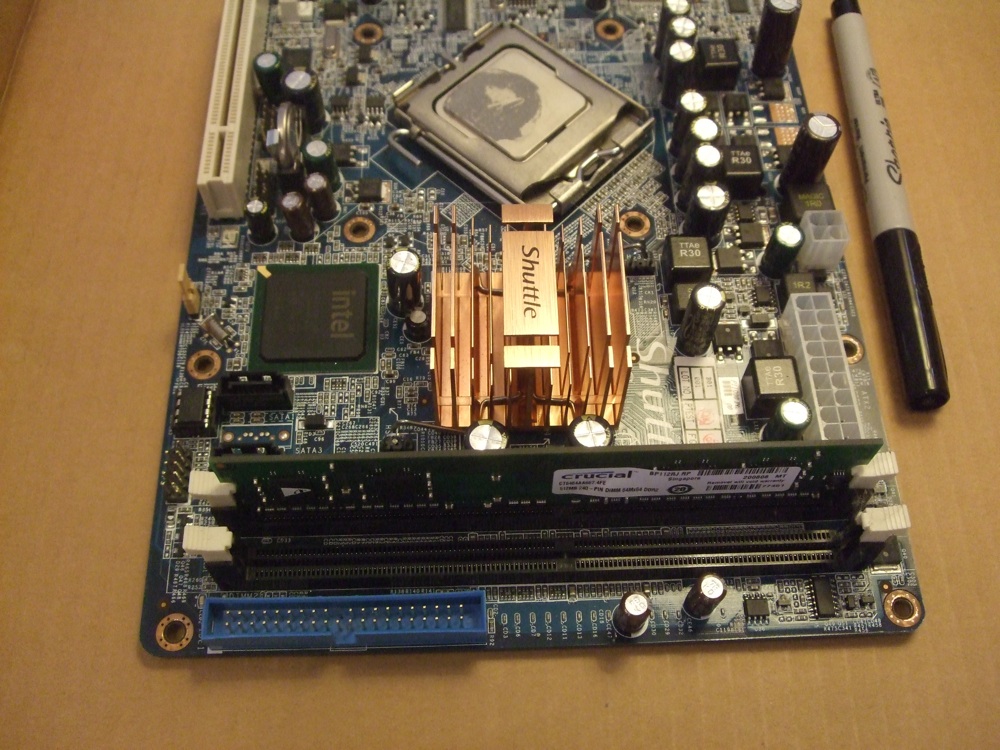
RAM is built with a few fries packaged together onto a petty card known equally a DIMM that plugs into the motherboard (dual inline memory module). Here we see the RAM DIMM removed from its motherboard socket. This is a 512MB DIMM built with 4 fries. A few years before, this DIMM might have required 8 chips in gild to store 512MB .. Moore's constabulary in action.
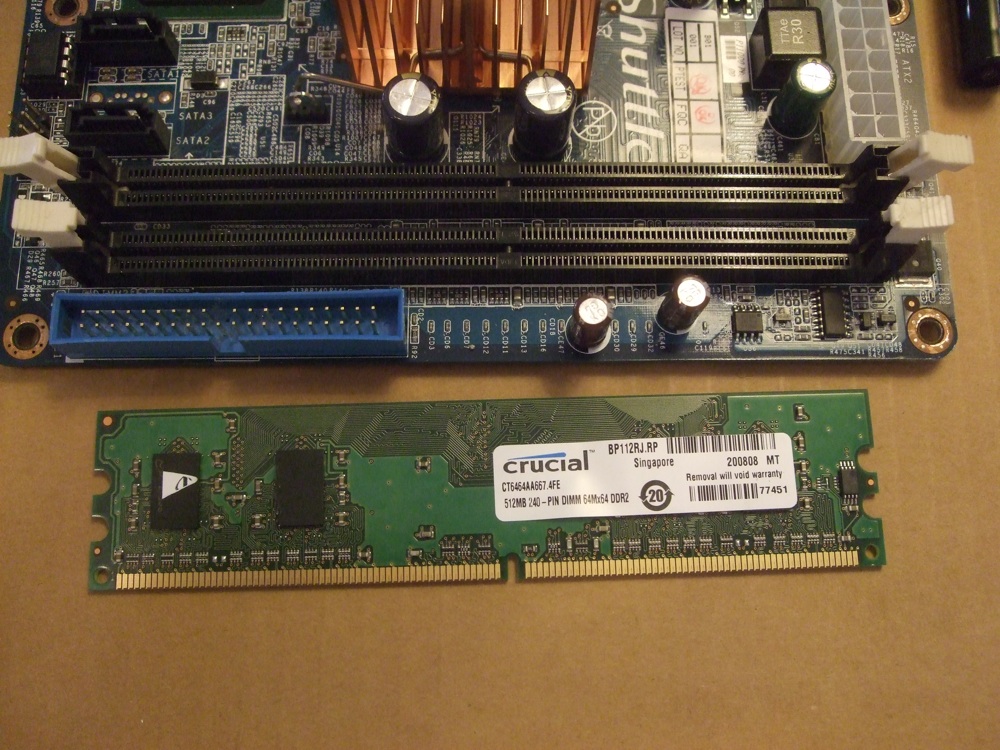
This is a hard bulldoze that connects to the motherboard with the visible standard SATA connector. This is a 160GB, "3.5 inch" bulldoze referring to the diameter of the spinning deejay inside; the whole drive is about the size of small paperback book. This is a standard disk size to utilize inside a desktop reckoner. Laptop computers utilise 2.5 inch drives, which are a bit smaller.
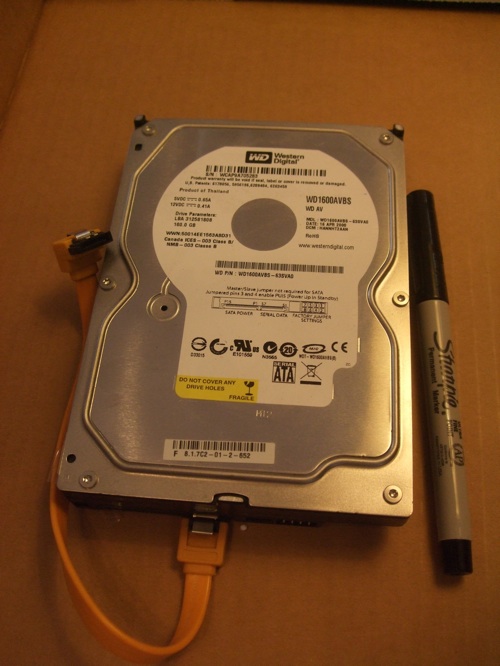
This is a USB flash bulldoze that, like a hard bulldoze, provides persistent byte storage. This is as well known equally a "thumb drive" or "USB fundamental". It is essentially a USB jack continued to a flash storage chip with some back up electronics:
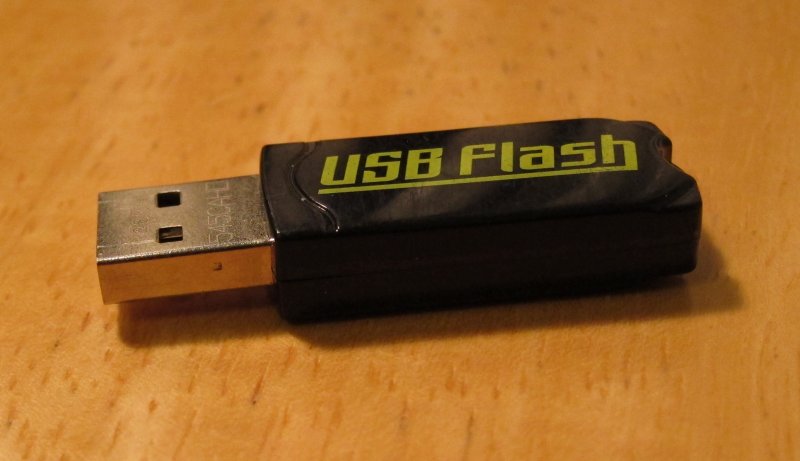
Here it is taken autonomously, showing the wink chip that actually stores the bytes. This chip can store nigh 1 billion $.25 .. how many bytes is that? (A: 8 bits per byte, and then that's most 125 MB)
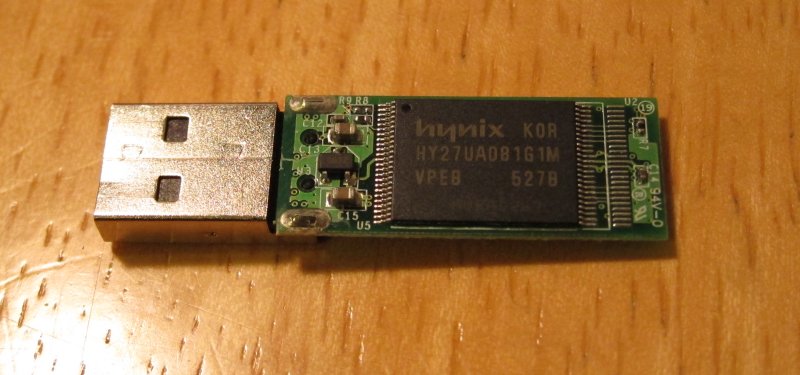
Hither is a "SD Card" which provides storage in a photographic camera. It's very like to the USB flash drive, just a different shape.
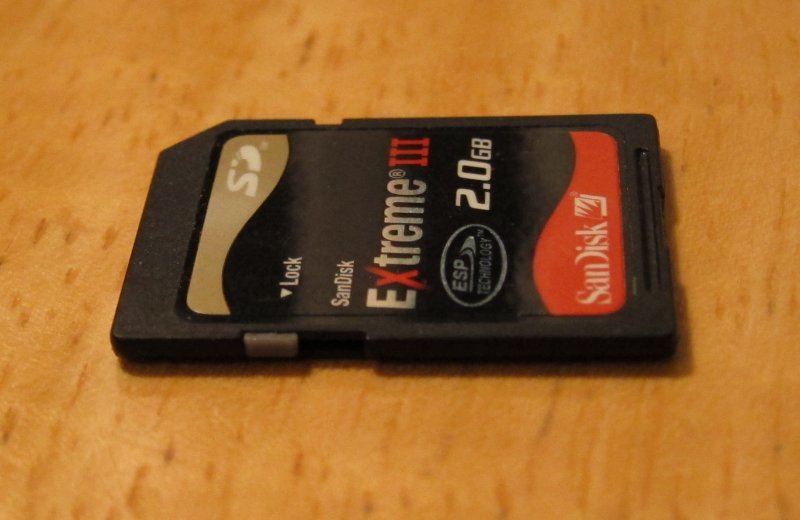
Microcontroller - Cheap Computer Chip
Arduino Computer
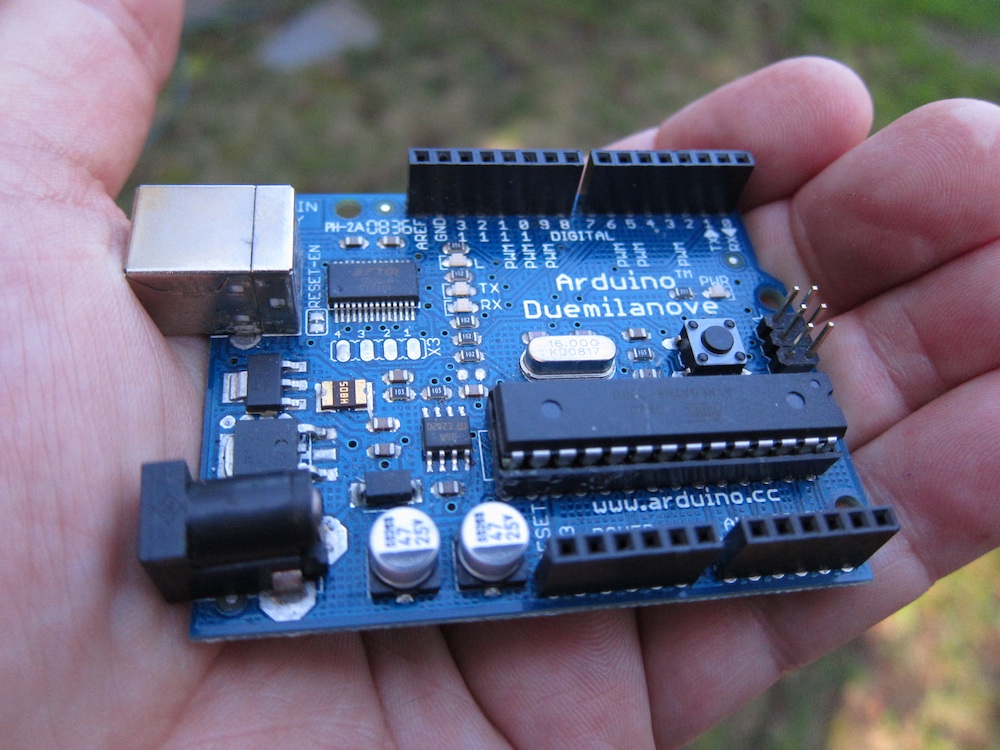
Source: https://web.stanford.edu/class/cs101/hardware-1.html
Posted by: hughesthind1949.blogspot.com


0 Response to "Which Of The Computer Components Below Will Most Likely Draw More Power Than The Others"
Post a Comment